Appendix A: Static Risk Assessments
Psychological Evaluations
Appendix A: Static Risk Assessments
STATIC-99R
The Static-99 was updated in 2012 to update the age item for the original scale, creating the Static-99R. In many states, the Static-99R is used to assess male sex offenders pre sentencing and prior to release from prison. The Static-99R is based on unchanging, static risk factors that predict the potential for sexual and violent reoffense. It ranks offenders in terms of their relative degree of risk for sexual recidivism based on commonly available demographic and criminal history information that has been found to correlate with sexual recidivism. The Static-99R cannot be used for women, juveniles, or those who have only been convicted of prostitution-related offenses. It is not intended for use with people who were only convicted of a child pornography offense. Further, it cannot be used to assess guilt or innocence.
The Static-99R sorts offenders into score categories. The coding rules were revised in 2016 to reflect new score literals for each numeric score. The following table reflects these revised coding rules as well as the former score literal for those scored before 2016:
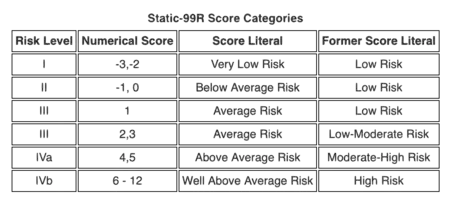
The numerical score is based on the following considerations. If the answer to a question is yes, a score of 1 is scored. For non yes/no questions, a score within the score range is given. The numbers are totaled to find the total score, and the risk level can then be calculated.[1]
Simplified Score Summary:
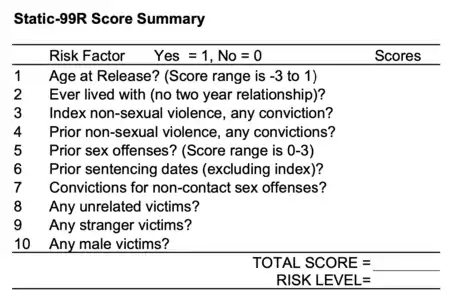
Full Tally Sheet:
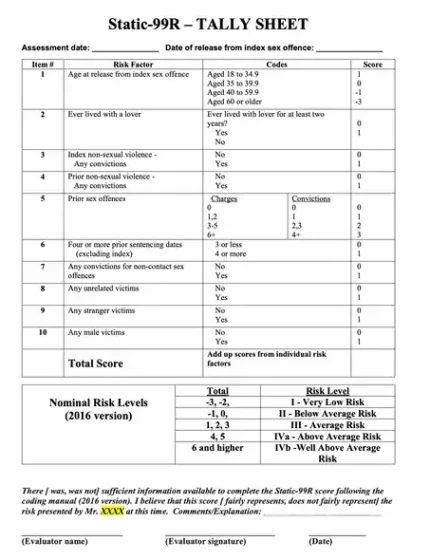
Generally, risk levels can be understood as follows:[2]
Level I/Very Low Risk: Individuals exhibit minimal and temporary criminogenic needs. They possess prosocial strengths, resulting in a low risk of new sexually criminal behavior, comparable to individuals with a non-sexual criminal history (around 0.4% per year). The prognosis is favorable, with most Level I people expected to desist from criminal behavior without a correctional response.
Level II/Below Average Risk: Individuals typically have few criminogenic needs and notable prosocial strengths. Moderate criminogenic needs, if present, are anticipated to be temporary rather than ingrained. The risk of new criminal behavior is lower than the average for sexually motivated offenses but higher than Level I. With appropriate correctional strategies or five years of offense-free community living, most people are expected to transition to Level I/Very Low Risk.
Level III/Average Risk: Individuals often have multiple criminogenic needs, posing barriers to utilizing prosocial resources. Their reoffending rate is comparable to the average for those convicted of sexually motivated offenses. About half are expected to transition to Level II within a year or two with treatment or positive life changes. Ultimately, all people in Level III are projected to transition to Level II or Level I after 10 to 15 years of offense-free living in the community.
Level IVa/Above Average Risk: Individuals typically exhibit numerous chronic and severe criminogenic needs, limiting access to prosocial resources. The rate of sexual reoffending for level IVa is approximately double the average for those convicted of sexually motivated offenses. A significant reduction in reoffending is expected, with many transitioning to level III within a year or two through treatment or positive life changes. Most people in Level IVa are projected to transition to Level III after sufficient treatment, positive life changes, or 10 to 15 years of offense-free living in the community.
Level IVb/Well Above Average Risk: Individuals typically have numerous chronic and severe criminogenic needs, limiting access to prosocial resources. The rate of sexual reoffending for Level IVb is approximately three to four times the average for individuals convicted of sexually motivated offenses. Most people in Level IVb are expected to transition to Level III through treatment, positive life changes, or maintaining offense-free living in the community for 10-15 years.
The Society for the Advancement of Actuarial Risk Needs Assessment (SAARNA) has summarized the above into the following table:
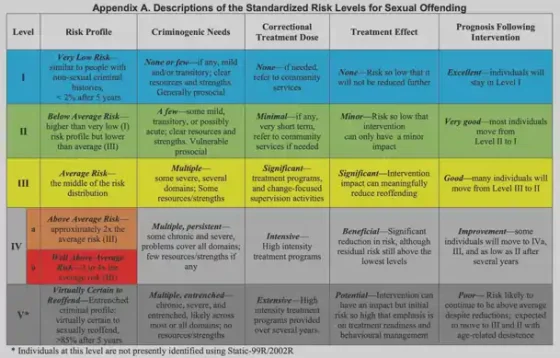
Research has found that on average, for every five years that an offender lives in their community without committing a new sex offense, their risk of sexual reoffense roughly halves.[3]
Estimated percentiles are as follows:
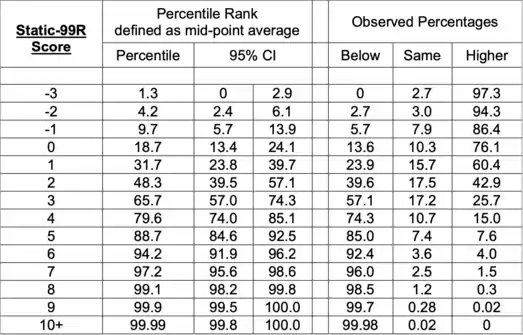
Research has been done to use Static-99R scores to predict recidivism five years after release from custody:
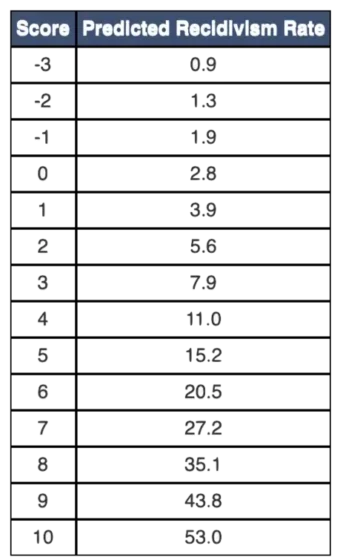
The decline in risk level based on initial Static-99R score over the years a person lives in their community without committing a sexual offense can be understood as follows:
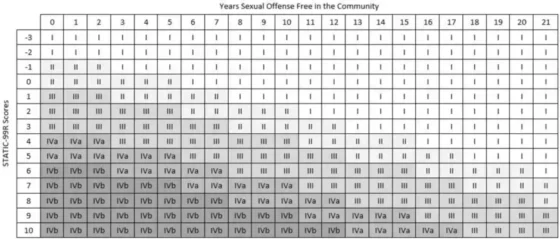
Each 99R point increases risk by .329 and each year sex offense free decreases risk by .130. Higher scores were not included because only around 0.08% of people have a score of 11 or 12.[4] Note that the Static-99R score does not change, but only the risk level (interpretation of the score) that changes over time.
To administer the Static-99R, a person should receive 8-12 hours of training, be retrained every 2-5 years, and receive a competency certification.
The Static-99 is likely the most widely used actuarial instrument across the United States and Canada.
[1] See the following for in-depth score calculation information. Please note that these materials are just for reference, and the score assessment needs to be performed by a professional. Phenix, A., Fernandez, Y., Harris, A. J. R., Helmus, M., Hanson, R. K., & Thornton, D. (2016). Static-99R Coding Rules: Revised – 2016. The Society for the Advancement of Actuarial Risk Needs Assessment.
[2] Hanson, R. K., Harris, A. J. R., Letourneau, E., Helmus, L. M., & Thornton, D. (2018). Reductions in risk based on time offense-free in the community: Once a sexual offender, not always a sexual offender. Psychology, Public Policy, and Law, 24(1), 48–63. https://doi.org/10.1037/law0000135; Helmus, L. M., Lee, S. C., Phenix, A., Hanson, R. K., & Thornton, D. (2021). Static-99R & Static-2002R Evaluators’ Workbook. Society for the Advancement of Actuarial Risk Needs Assessment.
[3] Hanson, R. K., Harris, A. J. R., Helmus, L., & Thornton, D. (2014). High risk sex offenders may not be high risk forever. Journal of Interpersonal Violence, 29(15), 2792-2813. doi:10.1177/0886260514526062
[4] Hanson, R.K. et al., Reductions in risk based on time offense free in the community: Once a sexual offender, not always a sexual offender, Psychology, Public Policy and Law, 2017
STATIC-2002
The Static-2002R evaluates the risk of sexual recidivism among adult males with a history of sexual offending. It assesses some theoretically meaningful characteristics presumed to be the cause of recidivism risk, including persistence of sexual offending, deviant sexual interests, and general criminality. The Static-2002R is not commonly used in the United States, but was developed and is widely used in Canada.[5]
[5] Static/Barr-2002R User. SAARNA. (n.d.-c). https://saarna.org/static-2002r/
RISK MATRIX 2000 (RM2000)
The RM2000 is a risk classification process designed for males 18 and older who have been convicted of a sexual offense, with at least offense committed when the offender was 17 or older. The assessment uses basic factual information about the person’s past history to categorize them based on differing rates of reconviction for sexual or other violent offenses. While it was developed for use in England and Wales, the international version omits jurisdiction-specific guidance regarding laws. The RM2000/S (Risk Matrix 200-Sex) Scale assesses risk for sexual recidivism, while the RM2000/V Scale assesses risk for non-sexual violent recidivism.[6]
The RM2000/S Scoring Form uses the following criteria:
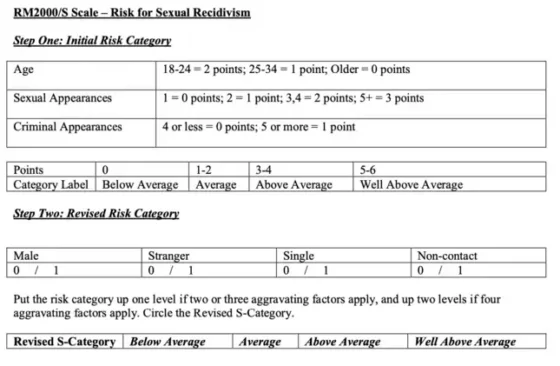
The categories correspond to the following recidivism rates and risk ratios:

Those in the “Below Average” category are expected to reoffend at about half the rate observed for typical convicted sex offenders, and will normally require less intensive risk management services than are typically provided for sexual offenders.
Those in the “Average” category are expected to sexually reoffend at the rate observed for typical convicted sex offenders, and the level of risk management services typically provided for sexual offenders will normally be appropriate for them.
Those in the “Above Average” category are expected to sexually reoffend at about twice the rate observed for typical convicted sex offenders, and normally require more intensive risk management services than are typically provided for sexual offenders.
Those in the “Well Above Average” category are expected to sexually reoffend at about four times the rate observed for typical convicted sex offenders, and normally require much more intensive risk management services than are typically provided for sexual offenders.
The RM2000/S is most commonly used in the United Kingdom.
[6]Risk Matrix-2000. SAARNA. (n.d.-a). https://saarna.org/risk-matrix-2000/
VERMONT ASSESSMENT OF SEX OFFENDER RISK-2 (VASOR-2)
The VASOR-2 is a static risk tool designed to assess risk among adult male sex offenders.[7] It is intended to be used with a dynamic risk measure such as the SOTIPS, and must be used by trained mental health professionals. However, it is not intended for use with people who were only convicted with a child pornography offense.
The VASOR-2 consists of a 12-item Reoffense Risk Scale, which is designed to assess the risk for sexual and violent recidivism, and a 4-item Severity Factors Checklist, which details the severity of sex offenses. Evaluators rely upon the person’s official criminal record, and may also conduct an interview with the individual. The Reoffense Risk Scale includes items relating to sexual and nonsexual offense history, victim characteristics, offender demographics, prior substance abuse, residence and employment stability, and sex offender treatment history. Scale scores range from 0 to 22 points and are organized into four risk groups: low (0 to 5), moderate-low (6 to 8), moderate-high (9 to 11), and high (12 to 22). This score helps professionals determine the probability of a reoffense. The Severity Factors Checklist includes items related to sexual intrusiveness, force used, physical victim harm, and victim vulnerability characteristics related to the person’s index sexual offenses. This checklist helps professionals determine the degree of harm most likely to result from a reoffense, but cannot yet be said to predict the severity of future sexual offenses.
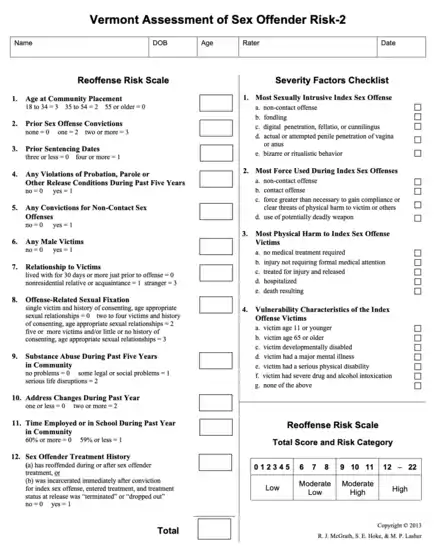
The VASOR-2 can be used as an aid in making sex offender placement, treatment, and supervision decisions, whether alone or in combination with the SOTIPS.
[7] McGrath, R. J., Hoke, S. E., & Lasher, M. P. (2013). Vermont Assessment of Sex Offender Risk-2 (VASOR-2) Manual. Middlebury, VT: Author.; McGrath, R. (n.d.-b). VASOR-2. McGrath Psychological Services, P. C. https://www.robertmcgrath.us/index.php/risk-instruments/vasor-2/


